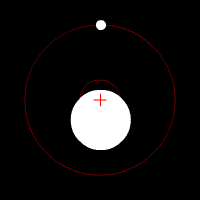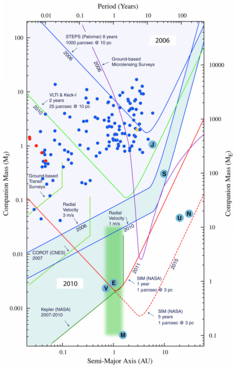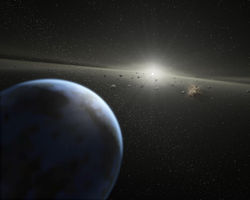Extrasolar planet
2007 Schools Wikipedia Selection. Related subjects: Space (Astronomy)
An extrasolar planet, or exoplanet, is a planet beyond the Solar System. As of 11 November 2006, 209 extrasolar planets have been discovered (see list of stars with known extrasolar planets).
Known exoplanets are members of planetary systems that orbit a star. There have also been unconfirmed reports of free-floating planetary-mass objects (that is, ones that do not orbit any star). Since such objects do not satisfy the working definition of "planet" adopted by the International Astronomical Union, and since their existence remains unconfirmed, they will not be discussed in this article. For more information, see interstellar planet.
For centuries, extrasolar planets were a subject of speculation. Astronomers generally supposed that some existed, but it was a mystery how common they were and how similar they were to the planets of the Solar System. The first confirmed detections were finally made in the 1990s. Since 2002, more than twenty have been discovered every year. It is now estimated that at least 10% of sunlike stars have planets, and the true proportion may be much higher. The discovery of extrasolar planets raises the question of whether some might support extraterrestrial life.
History of detection
Claims have been made for the detection of exoplanets going back many decades. Some of the earliest involve the binary star 70 Ophiuchi. In 1855 Capt. W. S. Jacob, working at the Madras Observatory of the East India Company reported that orbital anomalies made it "highly probable" that there was a "planetary body" in this system. In the 1890s, Thomas J. J. See of the University of Chicago and the United States Naval Observatory claimed that the orbital anomalies proved the existence of a dark body in the 70 Ophiuchi system, with a 36 year period around one of the stars. But shortly afterward Forest Ray Moulton published a paper proving that a three-body system with those orbital parameters would be highly unstable. During the 1950s and 1960s, Peter van de Kamp of Swarthmore College made another prominent series of detection claims, this time for planets orbiting Barnard's Star. Astronomers now generally regard all these early "detections" as erroneous.
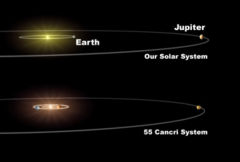
The first published discovery to have received subsequent confirmation was made in 1988 by the Canadian astronomers Bruce Campbell, G.A.H Walker, and S. Yang. Their radial-velocity observations suggested that a planet orbited the star Gamma Cephei (also known as Alrai). They remained cautious about claiming a true planetary detection, and widespread skepticism persisted in the astronomical community for several years about this and other similar observations. Mainly that was because the observations were at the very limits of instrumental capabilities at the time. Another source of confusion was that some of the possible planets might instead have been brown dwarfs, objects intermediate in mass between planets and stars.
The following year, additional observations were published that supported the reality of the planet orbiting Gamma Cephei. But subsequent work in 1992 raised serious doubts. Finally, in 2003, improved techniques allowed the planet's existence to be confirmed.
In 1991, Andrew Lyne, M. Bailes and S.L. Shemar claimed to have discovered a pulsar planet in orbit around PSR 1829-10, using pulsar timing variations. The claim briefly received intense attention, but Lyne and his team soon retracted it.
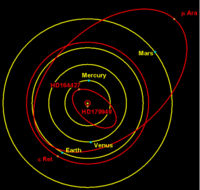
In early 1992, the Polish astronomer Aleksander Wolszczan (with Dale Frail) announced the discovery of planets around another pulsar, PSR 1257+12. This discovery was quickly confirmed, and is generally considered to be the first definitive detection of exoplanets. These pulsar planets are believed to have formed from the unusual remnants of the supernova that produced the pulsar, in a second round of planet formation, or else to be the remaining rocky cores of gas giants that survived the supernova and then spiralled in to their current orbits.
On October 6, 1995, Michel Mayor and Didier Queloz of the University of Geneva announced the first definitive detection of an exoplanet orbiting an ordinary main-sequence star ( 51 Pegasi). This discovery ushered in the modern era of exoplanetary discovery. Technological advances, most notably in high-resolution spectroscopy, led to the detection of many new exoplanets at a rapid rate. These advances allowed astronomers to detect exoplanets indirectly by measuring their gravitational influence on the motion of their parent stars. Several extrasolar planets were eventually also detected by observing the variation in a star's apparent luminosity as a planet passed in front of it.
As of October 9, 2006, 210 exoplanets have been found, including a few that were confirmations of controversial claims from the late 1980s. Many of these discoveries were made by a team led by Geoffrey Marcy at the University of California's Lick and Keck Observatories. The first system to have more than one planet detected was υ Andromedae. Twenty such multiple-planet systems are now known. Among the known exoplanets are four pulsar planets orbiting two separate pulsars. Infrared observations of circumstellar dust disks also suggest the existence of millions of comets in several extrasolar systems.
Detection methods
Planets are extremely faint light sources compared to their parent stars. In visible wavelengths, they usually have less than a millionth of their parent star's brightness. In addition to the intrinsic difficulty of detecting such a faint light source, the parent star causes a glare that washes it out.
For those reasons, current telescopes can only directly image exoplanets under exceptional circumstances. Specifically, it may be possible when the planet is especially large (considerably larger than Jupiter), widely separated from its parent star, and young (so that it is hot and emits intense infrared radiation).
The vast majority of known extrasolar planets have been discovered through indirect methods. At the present time, six different indirect methods have yielded success:
- Astrometry Consists of precisely measuring a star's position in the sky and observing how that position changes over time. If the star has a planet, then the gravitational influence of the planet will cause the star itself to move in a tiny circular or elliptical orbit.
- Radial velocity Also known as the "Doppler method" or "wobble method". Variations in the speed with which the star moves towards or away from Earth — i.e. variations in the radial velocity of the star with respect to Earth — can be deduced from the displacement in the parent star's spectral lines due to the Doppler effect. This has been by far the most productive technique used by planet hunters.
- Pulsar timing Pulsars (the small, ultradense remnant of a star that has exploded as a supernova) emit radio waves extremely regularly as they rotate. Slight anomalies in the timing of its observed radio pulses can be used to track changes in the pulsar's motion caused by the presence of planets.
- Transit method If a planet crosses ( transits) in front of its parent star's disk, then the observed visual brightness of the star drops a small amount. The amount the star dims depends on its size and on the size of the planet.
- Gravitational microlensing Occurs when the gravitational field of a star acts like a lens, magnifying the light of a distant background star. If the foreground lensing star has a planet, then that planet's own gravitational field can make a detectable contribution to the lensing effect.
- Circumstellar disks Disks of space dust surround many stars, which can be detected because it absorbs ordinary starlight and re-emits it as infrared radiation. Features in dust disks sometimes suggest the presence of full-sized planets.
For the future, several space missions are planned that will employ already proven planet-detection methods. Astronomical measurements done from space can be more sensitive than measurements done from the ground, since the distorting effect of the Earth's atmosphere is removed, and the instruments can view in infrared wavelengths that do not penetrate the atmosphere. Some of these space probes should be capable of detecting planets similar to our own Earth. Huge proposed ground telescopes may also be able to directly image extrasolar planets.
Nomenclature
A lower case letter is placed after the star name, starting with "b" for the first planet found in the system (e.g. 51 Pegasi b), with the next planet being for example "51 Pegasi c", then "51 Pegasi d"... (The letter "a" is not used because it might be interpreted as referring to the star itself.)
Planet naming conventions are based on discovery date - for example, the first planet detected will be designated with the letter "b." Any additional planets will be given additional letters regardless of position. A real world example is the Gliese 876 system: that latest discovered planet is Gliese876d, which is the closest orbiting planet.
Before the discovery of 51 Pegasi b in 1995, extrasolar planets were named differently. The first extrasolar planets found around pulsar PSR 1257+12 were named with capital letters: PSR 1257+12 B and PSR 1257+12 C. When a new, closer-in exoplanet was found around the pulsar, it was named PSR 1257+12 A, not D.
Several extrasolar planets also have unofficial nicknames. For example, HD 209458 b is unofficially called "Osiris", and 51 Pegasi b is called "Bellerophon."
General properties of exoplanets
Most known exoplanets orbit stars roughly similar to our own Sun—that is, main-sequence stars of spectral categories F, G, or K. One reason is simply that planet search programs have tended to concentrate on such stars. But even after taking that into account, statistical analysis suggests that lower-mass stars (red dwarfs, of spectral category M) are either less likely to have planets or have planets that are themselves of lower mass and hence harder to detect. Recent observations by the Spitzer Space Telescope indicate that planetary formation does not occur within the vicinity of an O class star due to the photo-evaporation effect.
All stars are composed mainly of the light elements hydrogen and helium. They also contain a small fraction of heavier elements such as iron; astronomers refer to that fraction as a star's metallicity. Stars of higher metallicity are much more likely to have planets, and the planets they have tend to be more massive than those of lower-metallicity stars.
The vast majority of exoplanets found so far have high masses. Ninety percent of them have more than 10 times the mass of Earth. Many are considerably more massive than Jupiter, our own Solar System's largest planet. However, these high masses are in large part an observational selection effect: All detection methods are much more likely to discover massive planets. That observational selection effect makes statistical analysis difficult, but it appears that lower-mass planets are actually more common than higher-mass ones, at least within a broad mass range that includes all giant planets. Also, the fact that astronomers have found several planets only a few times more massive than Earth, despite the great difficulty of detecting them, indicates that such planets are fairly common.
It is believed that the vast majority of known exoplanets are in substantial part gaseous, like the giant planets of our own Solar System. That has only been confirmed, however, for the exoplanets that have been studied with the transit method. A few of the smallest known exoplanets are suspected to be rocky, like Earth and the other inner planets of our Solar System.
Many exoplanets orbit much closer around their parent star than any planet in our own Solar System orbits around the Sun. Again, that is mainly an observational selection effect. The radial-velocity method is most sensitive to planets with such small orbits. Astronomers were initially very surprised by these " hot Jupiters," but it is now clear that most exoplanets (or at least, most high-mass exoplanets) have much larger orbits. It appears plausible that in most exoplanetary systems, there are one or two giant planets with orbits comparable in size to those of Jupiter and Saturn in our own Solar System.
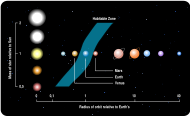
The eccentricity of an orbit is a measure of how elliptical (elongated) it is. Most known exoplanets have quite eccentric orbits. This is not an observational selection effect, since a planet can be detected about a star equally well regardless of how eccentric its orbit is. The prevalence of elliptical orbits is a major puzzle, since current theories of planetary formation strongly suggest planets should form with circular (non-eccentric) orbits. One possible theory is that small companions such as T dwarfs (methane bearing brown dwarfs) can hide in such solar systems and can cause the orbits of planets to be extreme. This is also an indication that our own Solar System may be unusual, since all of its planets do follow basically circular orbits.
Many unanswered questions remain about the properties of exoplanets, such as details of their composition and how likely they are to have moons. One of the most intriguing questions about them is whether they might support life. Several planets do have orbits in their parent star's habitable zone, where it should be possible for Earth-like conditions to prevail. All of those planets are giant planets more similar to Jupiter than to Earth, so if they have large moons perhaps those would be the most plausible abode of life. Detection of life (other than an advanced civilization) at interstellar distances, however, is a tremendously challenging technical task that will not be feasible for many years, even if such life is commonplace.
Notable extrasolar planets


There have been a number of milestones in the discovery of extrasolar planets, beginning in 1992, when Wolszczan and Frail published results in Natureindicating that pulsar planets existed around PSR B1257+12. Wolszczan had discovered the millisecond pulsar in question in 1990 at the Arecibo radio observatory. These were the first exoplanets ever verified, and they are still considered highly unusual in that they orbit a pulsar.
The first verified discovery of an exoplanet ( 51 Pegasi b) orbiting a main sequence star ( 51 Pegasi) was announced by Michel Mayor and Didier Queloz in Nature on October 6, 1995. Astronomers were initially surprised by this "hot Jupiter" but soon set out to find other similar planets with great success.
Since that time, other notable discoveries have included:
- 1999, HD 209458 b
- This exoplanet, originally discovered with the radial-velocity method, became the first exoplanet to be seen transiting its parent star. The transit detection conclusively showed that the radial velocity measurements suspected to be planets actually were planets.
- 2001, HD 209458 b
- Astronomers using the Hubble Space Telescope announced that they had detected the atmosphere of HD 209458 b. They found the spectroscopic signature of sodium in the atmosphere, but at a smaller intensity than expected, suggesting that high clouds obscure the lower atmospheric layers.
- 2003, PSR B1620-26c
- On July 10, using information obtained from the Hubble Space Telescope, a team of scientists led by Steinn Sigurdsson confirmed the oldest extrasolar planet yet. The planet is located in the globular star cluster M4, about 5,600 light years from Earth in the constellation Scorpius. This is the only planet known to orbit around a stellar binary; one of the stars in the binary is a pulsar and the other is a white dwarf. The planet has a mass twice that of Jupiter, and is estimated to be 13 billion years old.
- 2004, Mu Arae d and TrES-1
- In August, a planet orbiting Mu Arae with a mass of approximately 14 times that of the Earth was discovered with the ESO HARPS spectrograph. It is the third lightest extrasolar planet orbiting a main sequence star to be discovered to date, and could be the first terrestrial planet around a main sequence star found outside the solar system. Further, a planet was discovered using the transit method with the smallest aperture telescope to date, 4 inches. The planet was discovered by the TrES survey, and provisionally named TrES-1, orbits the star GSC 02652-01324. The finding was confirmed by the Keck Observatory, where planetary specifics were uncovered.
- 2005, Gliese 876 d
- In June, a third planet orbiting the red dwarf star Gliese 876 was announced. With a mass estimated at 7.5 times that of Earth, it is currently the second-lightest known exoplanet that orbits an ordinary main-sequence star. It must almost certainly be rocky in composition. It orbits at 0.021 AU with a period of 1.94 days.
- 2005, HD 149026 b
- In July a planet with the largest core ever was announced. The planet, HD 149026 b orbits the star HD 149026, has a core that is estimated to be 70 Earth masses, accounting for two thirds of the planet's mass.
- 2005, HD 188753 Ab
- In July, astronomers announced the discovery of a planet in a relatively tight triple star system, a finding that challenges current theories of planetary formation. The planet, a gas giant slightly larger than Jupiter, orbits the main star of the HD 188753 system, in the constellation Cygnus, and is hence known as HD 188753 Ab. The stellar trio (yellow, orange, and red) is about 149 light years away from Earth. The planet orbits the main star (HD 188753 A) about once every 3.3 days, at a distance of about a twentieth the distance between Earth and the Sun. The other two stars whirl tightly around each other in 156 days, and circle the main star every 25.7 years at a distance from the main star that would put them between Saturn and Uranus in our own Solar system. The latter stars call into question the leading hot Jupiter formation theory, which holds that these planets form at "normal" distances and then migrate inward through some debatable mechanism. Such migration could not have occurred here, since the outer star pair would have disrupted outer planet formation.
- 2006, OGLE-2005-BLG-390Lb
- On January 25 the discovery of OGLE-2005-BLG-390Lb was announced. This is the most distant and probably the coldest exoplanet yet found. It is believed to orbit a red dwarf star around 21,500 light years away, towards the centre of our galaxy. It was discovered using gravitational microlensing and is estimated to have a mass of 5.5 times that of Earth, making it the least massive known exoplanet to orbit an ordinary main-sequence star. Prior to this discovery, the few known exoplanets with comparably low masses had only been discovered on orbits very close to their parent stars, but this planet is estimated to have a relatively wide separation of 2.6 AU from its parent star.
- 2006, HAT-P-1b
- Using a network of small automated telescopes known as HAT, Smithsonian astronomers discovered a planet, since designated HAT-P-1b, that orbits one member of a pair of distant stars 450 light-years away in the constellation Lacerta. The planet has a radius 1.38 times that of Jupiter, but one-half the density, making it the least dense planet on record. It remains unclear how such a planet could evolve, and it is believed this object and HD 209458 b (also a low-density giant planet) could ultimately provide insight on how planets form. According to Robert Noyes of the Harvard-Smithsonian Centre for Astrophysics (CfA), "We can't dismiss HD 209458 b as a fluke. This new discovery suggests something could be missing in our theories of how planets form."
- 2006, SWEEPS-10
- The planet candidate with the shortest orbital period yet found, named SWEEPS-10, completes a full orbit of its star in just 10 hours. Located only 1.2 million kilometres from its star (roughly three times the distance between the Earth and the Moon), the planet is among the hottest ever detected, with an estimated temperature of about 1650 degrees C. "This star-hugging planet must be at least 1.6 times the mass of Jupiter, otherwise the star’s gravitational muscle would pull the planet apart," said team leader Kailash Sahu of the Space Telescope Science Institute in Baltimore, USA. Such ultra-short period planets (USPPs) seem to occur only around dwarf stars. The smaller star’s relatively lower temperature allows the planet to exist. "USPPs occur preferentially around normal red dwarf stars that are smaller and cooler than our Sun," Sahu said.
